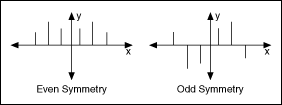N samples of the input signal result in N samples of the discrete Fourier transform (DFT). That is, the number of samples in both the time and frequency representations is the same. The following equation shows that regardless of whether the input signal x[i] is real or complex, X[k] is always complex, although the imaginary part may be zero.
In other words, every frequency component has a magnitude and phase.
Normally the magnitude of the spectrum is displayed. The magnitude is the square root of the sum of the squares of the real and imaginary parts.
The phase is relative to the start of the time record or relative to a single-cycle cosine wave starting at the beginning of the time record. Single-channel phase measurements are stable only if the input signal is triggered. Dual-channel phase measurements compute phase differences between channels so if the channels are sampled simultaneously, triggering usually is not necessary.
The phase is the arctangent of the ratio of the imaginary and real parts and is usually between π and -π radians, or 180 and -180 degrees.
For real signals (x[i] real), such as those you obtain from the output of one channel of a DAQ device, the DFT is symmetric with properties given by the following equations.


The magnitude of X[k] is even symmetric, and phase(X[k]) is odd symmetric. An even symmetric signal is symmetric about the y-axis, and an odd symmetric signal is symmetric about the origin. The following figure shows even and odd symmetry.

Because of this symmetry, the N samples of the DFT contain repetition of information. Because of this repetition of information, only half of the samples of the DFT actually need to be computed or displayed because you can obtain the other half from this repetition. If the input signal is complex, the DFT is asymmetrical, and you cannot use only half of the samples to obtain the other half.
